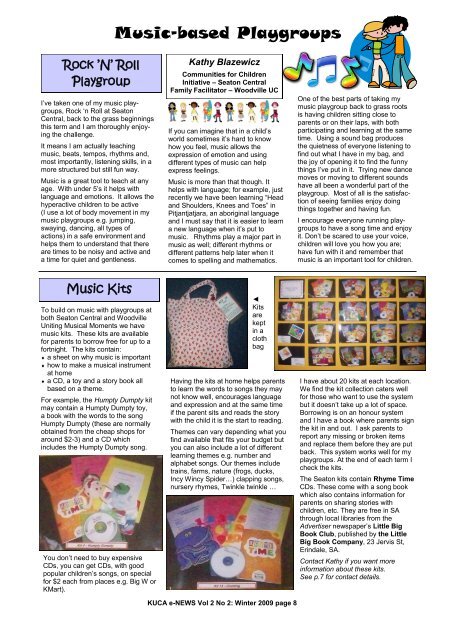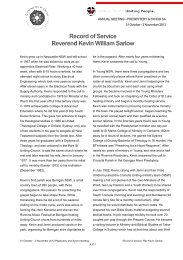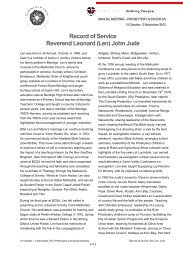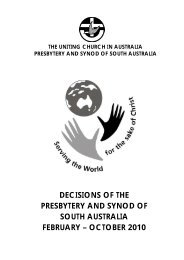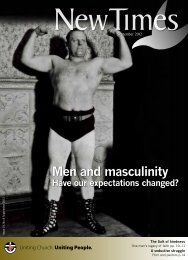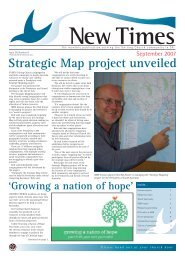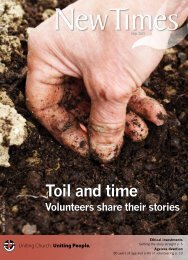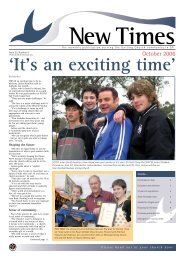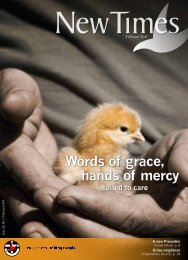Music and Playgroups - Uniting Church in Australia
Music and Playgroups - Uniting Church in Australia
Music and Playgroups - Uniting Church in Australia
You also want an ePaper? Increase the reach of your titles
YUMPU automatically turns print PDFs into web optimized ePapers that Google loves.
Rock ’N’ Roll<br />
Playgroup<br />
I‟ve taken one of my music playgroups,<br />
Rock „n Roll at Seaton<br />
Central, back to the grass beg<strong>in</strong>n<strong>in</strong>gs<br />
this term <strong>and</strong> I am thoroughly enjoy<strong>in</strong>g<br />
the challenge.<br />
It means I am actually teach<strong>in</strong>g<br />
music, beats, tempos, rhythms <strong>and</strong>,<br />
most importantly, listen<strong>in</strong>g skills, <strong>in</strong> a<br />
more structured but still fun way.<br />
<strong>Music</strong> is a great tool to teach at any<br />
age. With under 5‟s it helps with<br />
language <strong>and</strong> emotions. It allows the<br />
hyperactive children to be active<br />
(I use a lot of body movement <strong>in</strong> my<br />
music playgroups e.g. jump<strong>in</strong>g,<br />
sway<strong>in</strong>g, danc<strong>in</strong>g, all types of<br />
actions) <strong>in</strong> a safe environment <strong>and</strong><br />
helps them to underst<strong>and</strong> that there<br />
are times to be noisy <strong>and</strong> active <strong>and</strong><br />
a time for quiet <strong>and</strong> gentleness.<br />
<strong>Music</strong> Kits<br />
To build on music with playgroups at<br />
both Seaton Central <strong>and</strong> Woodville<br />
<strong>Unit<strong>in</strong>g</strong> <strong>Music</strong>al Moments we have<br />
music kits. These kits are available<br />
for parents to borrow free for up to a<br />
fortnight. The kits conta<strong>in</strong>:<br />
a sheet on why music is important<br />
how to make a musical <strong>in</strong>strument<br />
at home<br />
a CD, a toy <strong>and</strong> a story book all<br />
based on a theme.<br />
For example, the Humpty Dumpty kit<br />
may conta<strong>in</strong> a Humpty Dumpty toy,<br />
a book with the words to the song<br />
Humpty Dumpty (these are normally<br />
obta<strong>in</strong>ed from the cheap shops for<br />
around $2-3) <strong>and</strong> a CD which<br />
<strong>in</strong>cludes the Humpty Dumpty song.<br />
You don‟t need to buy expensive<br />
CDs, you can get CDs, with good<br />
popular children‟s songs, on special<br />
for $2 each from places e.g. Big W or<br />
KMart).<br />
<strong>Music</strong>-based <strong>Playgroups</strong><br />
Kathy Blazewicz<br />
Communities for Children<br />
Initiative – Seaton Central<br />
Family Facilitator – Woodville UC<br />
If you can imag<strong>in</strong>e that <strong>in</strong> a child‟s<br />
world sometimes it‟s hard to know<br />
how you feel, music allows the<br />
expression of emotion <strong>and</strong> us<strong>in</strong>g<br />
different types of music can help<br />
express feel<strong>in</strong>gs.<br />
<strong>Music</strong> is more than that though. It<br />
helps with language; for example, just<br />
recently we have been learn<strong>in</strong>g “Head<br />
<strong>and</strong> Shoulders, Knees <strong>and</strong> Toes” <strong>in</strong><br />
Pitjantjatjara, an aborig<strong>in</strong>al language<br />
<strong>and</strong> I must say that it is easier to learn<br />
a new language when it‟s put to<br />
music. Rhythms play a major part <strong>in</strong><br />
music as well; different rhythms or<br />
different patterns help later when it<br />
comes to spell<strong>in</strong>g <strong>and</strong> mathematics.<br />
◄<br />
Kits<br />
are<br />
kept<br />
<strong>in</strong> a<br />
cloth<br />
bag<br />
Hav<strong>in</strong>g the kits at home helps parents<br />
to learn the words to songs they may<br />
not know well, encourages language<br />
<strong>and</strong> expression <strong>and</strong> at the same time<br />
if the parent sits <strong>and</strong> reads the story<br />
with the child it is the start to read<strong>in</strong>g.<br />
Themes can vary depend<strong>in</strong>g what you<br />
f<strong>in</strong>d available that fits your budget but<br />
you can also <strong>in</strong>clude a lot of different<br />
learn<strong>in</strong>g themes e.g. number <strong>and</strong><br />
alphabet songs. Our themes <strong>in</strong>clude<br />
tra<strong>in</strong>s, farms, nature (frogs, ducks,<br />
Incy W<strong>in</strong>cy Spider…) clapp<strong>in</strong>g songs,<br />
nursery rhymes, Tw<strong>in</strong>kle tw<strong>in</strong>kle …<br />
KUCA e-NEWS Vol 2 No 2: W<strong>in</strong>ter 2009 page 8<br />
One of the best parts of tak<strong>in</strong>g my<br />
music playgroup back to grass roots<br />
is hav<strong>in</strong>g children sitt<strong>in</strong>g close to<br />
parents or on their laps, with both<br />
participat<strong>in</strong>g <strong>and</strong> learn<strong>in</strong>g at the same<br />
time. Us<strong>in</strong>g a sound bag produces<br />
the quietness of everyone listen<strong>in</strong>g to<br />
f<strong>in</strong>d out what I have <strong>in</strong> my bag, <strong>and</strong><br />
the joy of open<strong>in</strong>g it to f<strong>in</strong>d the funny<br />
th<strong>in</strong>gs I‟ve put <strong>in</strong> it. Try<strong>in</strong>g new dance<br />
moves or mov<strong>in</strong>g to different sounds<br />
have all been a wonderful part of the<br />
playgroup. Most of all is the satisfaction<br />
of see<strong>in</strong>g families enjoy do<strong>in</strong>g<br />
th<strong>in</strong>gs together <strong>and</strong> hav<strong>in</strong>g fun.<br />
I encourage everyone runn<strong>in</strong>g playgroups<br />
to have a song time <strong>and</strong> enjoy<br />
it. Don‟t be scared to use your voice,<br />
children will love you how you are;<br />
have fun with it <strong>and</strong> remember that<br />
music is an important tool for children.<br />
I have about 20 kits at each location.<br />
We f<strong>in</strong>d the kit collection caters well<br />
for those who want to use the system<br />
but it doesn‟t take up a lot of space.<br />
Borrow<strong>in</strong>g is on an honour system<br />
<strong>and</strong> I have a book where parents sign<br />
the kit <strong>in</strong> <strong>and</strong> out. I ask parents to<br />
report any miss<strong>in</strong>g or broken items<br />
<strong>and</strong> replace them before they are put<br />
back. This system works well for my<br />
playgroups. At the end of each term I<br />
check the kits.<br />
The Seaton kits conta<strong>in</strong> Rhyme Time<br />
CDs. These come with a song book<br />
which also conta<strong>in</strong>s <strong>in</strong>formation for<br />
parents on shar<strong>in</strong>g stories with<br />
children, etc. They are free <strong>in</strong> SA<br />
through local libraries from the<br />
Advertiser newspaper‟s Little Big<br />
Book Club, published by the Little<br />
Big Book Company, 23 Jervis St,<br />
Er<strong>in</strong>dale, SA.<br />
Contact Kathy if you want more<br />
<strong>in</strong>formation about these kits.<br />
See p.7 for contact details.
Rock ’n’ Roll <strong>Music</strong>: What it looks like<br />
Welcome <strong>and</strong> sign <strong>in</strong><br />
There are toys placed outside <strong>and</strong> <strong>in</strong><br />
other rooms for the children to access<br />
<strong>and</strong> <strong>in</strong>side the Rock „n Roll room is a<br />
craft for the children <strong>and</strong> parents to<br />
do. I try not to have toys <strong>in</strong> the room<br />
where I am do<strong>in</strong>g music as it is unsafe<br />
to have clutter, especially <strong>in</strong> big<br />
groups. Make sure safety comes first<br />
especially when you are mov<strong>in</strong>g.<br />
Craft: mak<strong>in</strong>g an <strong>in</strong>strument<br />
(This allows everyone time to come <strong>in</strong><br />
before the music beg<strong>in</strong>s.)<br />
<strong>Music</strong> time (approximately 20<br />
m<strong>in</strong>utes – depend<strong>in</strong>g on attention<br />
span of children)<br />
Each child picks a percussion<br />
<strong>in</strong>strument <strong>and</strong> sits down with<br />
parent/carer<br />
Beats: (this gets the attention <strong>and</strong><br />
focus of everyone). I start with the<br />
“crotchet” or 1 beat note (which I<br />
call Tahn) <strong>and</strong> I count as we clap<br />
<strong>and</strong> play <strong>in</strong>struments. I also use my<br />
body <strong>and</strong> stamp the beat so that the<br />
children can feel the beat through<br />
the floor. When it comes time to<br />
stop I put my h<strong>and</strong> up <strong>and</strong> my other<br />
h<strong>and</strong> to my mouth to say „Shh!! ‟<br />
The children catch on very quickly<br />
to the action, even the smallest<br />
ones. Of course at this age you<br />
can‟t expect them all to do it at the<br />
same time or wait for the straggler<br />
so you keep the flow go<strong>in</strong>g. Other<br />
names I use for notes are Tee-Tee,<br />
Tick-a-Tock-a – these came from<br />
the music teacher who started<br />
<strong>Music</strong>al Moments at Woodville.<br />
Welcome song – I <strong>in</strong>clude the<br />
children‟s names <strong>in</strong> the song: e.g.<br />
Oh what do you th<strong>in</strong>k my name is,<br />
I wonder if you know?<br />
My name is Kathy hello, hello, hello,<br />
hello, hello, hello, hello.<br />
Oh what do you th<strong>in</strong>k his/her name<br />
is, I wonder if you know?<br />
His/her name is ..... hello, hello,<br />
hello, hello, hello, hello, hello.<br />
The Hello Song from The Fairies is<br />
also a good one.<br />
I try <strong>and</strong> keep the same songs at the<br />
start <strong>and</strong> f<strong>in</strong>ish as it becomes a signal<br />
to the children what's happen<strong>in</strong>g.<br />
Songs: I use songs with actions as<br />
well as quiet songs throughout the<br />
session. Common songs are the<br />
best as the parents know them but<br />
sometimes I teach the parents new<br />
songs <strong>and</strong> give them the words to<br />
help them. Us<strong>in</strong>g your own words to<br />
common tunes can also be an<br />
advantage at times.<br />
Actions e.g. „we‟re go<strong>in</strong>g up‟, help<br />
children to know that music isn‟t the<br />
same all the time, it rises <strong>and</strong> falls;<br />
<strong>and</strong> by do<strong>in</strong>g this with out bodies we<br />
help them make the connection.<br />
The „Sound Bag‟ is someth<strong>in</strong>g I use<br />
dur<strong>in</strong>g the session. I have different<br />
sounds e.g. bells, squeaky toys or<br />
scrunched up cellophane paper.<br />
The children have to listen to f<strong>in</strong>d<br />
out what I have <strong>in</strong> the bag <strong>and</strong> when<br />
they have a guess I give them the<br />
chance to look <strong>in</strong> my bag to see<br />
what it is. This only lasts as long as<br />
the attention of the children; if they<br />
aren‟t listen<strong>in</strong>g drop it <strong>and</strong> go back<br />
to songs, try aga<strong>in</strong> later.<br />
I cont<strong>in</strong>ue the music with action <strong>and</strong><br />
quiet songs aga<strong>in</strong> <strong>and</strong> then f<strong>in</strong>ish<br />
with a song to pack away the<br />
musical <strong>in</strong>struments. (It's great to<br />
teach children to put away <strong>and</strong> tidy<br />
up as well.) Our pack up song is:<br />
Let's put the <strong>in</strong>struments away <strong>in</strong><br />
their box, put the <strong>in</strong>struments away,<br />
Let's put the <strong>in</strong>struments away <strong>in</strong> the<br />
box, we'll use them on another day.<br />
This normally lasts 15-20 m<strong>in</strong>utes.<br />
We then go off to wash our h<strong>and</strong>s<br />
(with another song) <strong>and</strong> have fruit<br />
time.<br />
This is the way we wash our h<strong>and</strong>s,<br />
wash our h<strong>and</strong>s, wash our h<strong>and</strong>s,<br />
This is the way we wash our h<strong>and</strong>s<br />
here at Rock 'n Roll Playgroup.<br />
This is the way we dry our h<strong>and</strong>s,<br />
dry our h<strong>and</strong>s, dry our h<strong>and</strong>s,<br />
This is the way we dry our h<strong>and</strong>s<br />
here at Rock 'n Roll Playgroup.<br />
or<br />
Wash your dirty h<strong>and</strong>s,<br />
wash your dirty h<strong>and</strong>s,<br />
Rub <strong>and</strong> scrub <strong>and</strong> rub <strong>and</strong> scrub<br />
<strong>and</strong> wash your dirty h<strong>and</strong>s.<br />
At <strong>Music</strong>al Moments at Woodville I<br />
use a grace before we eat:<br />
Thank you God for the grub boom<br />
boom boom,<br />
Thank you God for provid<strong>in</strong>g for us,<br />
I hope we're not greedy,<br />
I hope we're not speedy,<br />
Just want to thank you for the grub.<br />
One, Two, Three: THANKS.<br />
We beat the rhythm on the tables as<br />
we s<strong>in</strong>g <strong>and</strong> the children look forward<br />
to it. Leanne from Henley Fulham<br />
uses a softer, spoken grace <strong>and</strong> that<br />
works for her, so it's a matter of f<strong>in</strong>d<strong>in</strong>g<br />
what's right for you.<br />
KUCA e-NEWS Vol 2 No 2: W<strong>in</strong>ter 2009 page 9<br />
Dance: I use CD‟s for dance – High<br />
5, Fairies, Rock „n Roll for Kids or<br />
even classical music, to give children<br />
different musical experiences.<br />
Sometimes I use scarves or<br />
danc<strong>in</strong>g ribbons to help out.<br />
Parents can copy your dance or<br />
you can teach them an easy step.<br />
(I never worry about the proper<br />
dance steps at this age.)<br />
The steps I use are: hold<strong>in</strong>g h<strong>and</strong>s<br />
with the child, gently pull them <strong>in</strong>to<br />
you <strong>and</strong> out aga<strong>in</strong> – this is done<br />
twice <strong>and</strong> you count as you go; on<br />
the 3 rd time you twirl them under<br />
your arm. Children get to know that<br />
on the count of 3 they twirl.<br />
Other dances can be High 5 <strong>and</strong><br />
the actions that go with the song<br />
you are us<strong>in</strong>g e.g. hide your eyes<br />
(cover eyes with h<strong>and</strong>s) <strong>and</strong> count<br />
to 10 (hold<strong>in</strong>g up 10 f<strong>in</strong>gers), ready<br />
or not (move h<strong>and</strong>s <strong>in</strong> front of you <strong>in</strong><br />
a runn<strong>in</strong>g motion) I‟m go<strong>in</strong>g to f<strong>in</strong>d<br />
you aga<strong>in</strong> (h<strong>and</strong> above your eyes<br />
look<strong>in</strong>g out)<br />
Group dance: We always end our<br />
dance time with old favourites e.g.<br />
R<strong>in</strong>g a r<strong>in</strong>g a rosie (but I use names<br />
<strong>in</strong>stead of „a- tishoo‟) <strong>and</strong> the Hokey<br />
Pokey.<br />
Sometimes I use a parachute to<br />
keep the circle. (However, children<br />
get very excited when the parachute<br />
comes out.)<br />
Goodbye song (sometimes us<strong>in</strong>g a<br />
parachute to hide the children)<br />
Where are the children, where are<br />
the children?<br />
Here they are, here they are.<br />
We've had fun at playgroup, we've<br />
had fun at playgroup,<br />
Bye for now, bye for now.<br />
Sung to Frére Jacques<br />
(This is a common playgroup one)<br />
As long as you are enthusiastic about<br />
what you do <strong>and</strong> you do it your way<br />
the children will love it. It doesn't<br />
matter if you can't s<strong>in</strong>g or dance<br />
properly, or get out of time every now<br />
<strong>and</strong> then, as long as you are enjoy<strong>in</strong>g<br />
it. The children sense when you're not<br />
comfortable <strong>and</strong> you won‟t get the<br />
same response.<br />
Resources:<br />
The New Useful Book from ABC Play<br />
School is very helpful with music <strong>and</strong><br />
ideas, th<strong>in</strong>gs to make <strong>and</strong> h<strong>in</strong>ts. It‟s<br />
normally available at the ABC shop<br />
<strong>and</strong> some other big book stores.<br />
The other book I f<strong>in</strong>d useful, although<br />
harder to obta<strong>in</strong>, is the Merrily,<br />
Merrily book of songs <strong>and</strong> rhymes<br />
from the Nurs<strong>in</strong>g Mothers' Association<br />
of <strong>Australia</strong>.
Playgroup: <strong>Music</strong>al Instruments<br />
Mak<strong>in</strong>g <strong>Music</strong>al Instruments<br />
Some of the best musical <strong>in</strong>struments<br />
are home made. I have <strong>in</strong>cluded a<br />
couple of favourites:<br />
SHAKERS<br />
You will need:<br />
cardboard tubes<br />
cardboard circles slightly bigger<br />
than the ends of the tubes<br />
paper to cover the cardboard tubes<br />
sticky tape<br />
textas, pencils or stickers<br />
rice, pasta, beads, bells<br />
What to do:<br />
Snip around the<br />
cardboard circles<br />
just enough to be<br />
able to fit around the<br />
outside of the tube.<br />
Sticky tape one circle <strong>in</strong><br />
place.<br />
Fill the tube with a couple of tablespoons<br />
of rice, pasta etc. until you<br />
have the sound you are look<strong>in</strong>g for.<br />
(Different items will give softer or<br />
louder sounds).<br />
Sticky tape the other circle <strong>in</strong> place.<br />
A child can draw on the paper <strong>and</strong><br />
decorate it prior to cover<strong>in</strong>g the tube<br />
or you can cover the tube with the<br />
paper <strong>and</strong> decorate with stickers<br />
etc.<br />
RAINMAKERS (shakers that sound<br />
like ra<strong>in</strong> fall<strong>in</strong>g)<br />
Make it as you would make a shaker,<br />
except that you fill the <strong>in</strong>side of the<br />
tube with bubble wrap prior to add<strong>in</strong>g<br />
rice (allow room for the rice to be able<br />
to fall gently through the bubble wrap<br />
when you turn it up <strong>and</strong> down).<br />
You can also fill the tube with<br />
twisted alum<strong>in</strong>ium foil for a<br />
similar effect.<br />
◄Ra<strong>in</strong> stick craft from<br />
KUCA News<br />
W<strong>in</strong>ter 2005<br />
page 26<br />
DRUMS<br />
You will need:<br />
a can e.g. milo or baby formula<br />
(please make sure it‟s clean <strong>and</strong><br />
has no sharp edges)<br />
thick plastic<br />
sticky tape<br />
paper to cover the outside of the<br />
can<br />
textas, pencils or stickers<br />
str<strong>in</strong>g: enough to fit over child‟s<br />
head so that the drum sits <strong>in</strong> front of<br />
their tummy<br />
pencils not sharpened, chop sticks<br />
or wooden spoon<br />
N.B. If the cans have a plastic lid<br />
already these can be used <strong>in</strong>stead of<br />
the thick plastic.<br />
What to do:<br />
Knot each end of the str<strong>in</strong>g <strong>and</strong><br />
place underneath plastic lid (or<br />
between plastic cuts.) If you like<br />
<strong>in</strong>stead you can punch holes <strong>in</strong> the<br />
side of the can carefully <strong>and</strong> <strong>in</strong>sert<br />
the str<strong>in</strong>g <strong>and</strong> tie off. N.B. Children<br />
should be supervised if us<strong>in</strong>g str<strong>in</strong>g<br />
around the neck.<br />
If us<strong>in</strong>g thick plastic, snip edges so<br />
that plastic will fit over can, pull tight<br />
as possible as this make the drum‟s<br />
sk<strong>in</strong> sound better.<br />
A child can draw on the paper <strong>and</strong><br />
decorate it prior to cover<strong>in</strong>g the can,<br />
or you can cover the can with the<br />
paper <strong>and</strong> decorate with<br />
stickers etc.<br />
Chop sticks, spoons etc. make great<br />
drum sticks<br />
If the child turns the drum over <strong>and</strong><br />
hits on the t<strong>in</strong> side a different sound<br />
will be heard (beware this is a lot<br />
louder).<br />
Of course you can<br />
always use upside<br />
down saucepans<br />
<strong>and</strong> wooden<br />
spoons for drums.<br />
KUCA e-NEWS Vol 2 No 2: W<strong>in</strong>ter 2009 page 10<br />
by Kathy Blazewicz<br />
Email: kathyblaze@ozemail.com.au<br />
GUITARS<br />
You will need:<br />
tissue box<br />
rubber b<strong>and</strong>s<br />
sticky tape<br />
tube<br />
What to do:<br />
Snip cardboard tube at<br />
one end, feather out<br />
<strong>and</strong> stick on end of<br />
tissue box with sticky<br />
tape.<br />
Place rubber b<strong>and</strong>s<br />
over tissue box.<br />
N.B. IMPORTANT:<br />
Sticky tape rubber<br />
b<strong>and</strong>s at side of box; if<br />
they break they will not<br />
fl<strong>in</strong>g off <strong>and</strong> hurt anyone.<br />
XYLOPHONE<br />
Hang metal objects of various sizes<br />
on a l<strong>in</strong>e <strong>and</strong> hit with a wooden<br />
spoon.<br />
Try us<strong>in</strong>g saucepans, col<strong>and</strong>ers,<br />
metal spoons of various sizes, large<br />
washers etc.<br />
“Heads, shoulders, knees,<br />
toes” <strong>in</strong> Pitjantjatjara<br />
kata, alipiri,<br />
muti, tj<strong>in</strong>a<br />
(heads, shoulders<br />
knees, toes)<br />
muti, tj<strong>in</strong>a<br />
muti, tj<strong>in</strong>a<br />
kata, alipiri,<br />
muti, tj<strong>in</strong>a<br />
toes tj<strong>in</strong>a<br />
we all clap h<strong>and</strong>s together<br />
p<strong>in</strong>a, kuru, w<strong>in</strong>p<strong>in</strong>pi, mulya<br />
(ears, eyes, mouth, nose)<br />
p<strong>in</strong>a, kuru,<br />
p<strong>in</strong>a, kuru,<br />
p<strong>in</strong>a, kuru, w<strong>in</strong>p<strong>in</strong>pi, mulya<br />
we all clap h<strong>and</strong>s together.<br />
One of the activities that we did with<br />
this song was to draw around the<br />
bodies of each of the children on<br />
butcher‟s paper <strong>and</strong> add the words<br />
<strong>and</strong> pictures to their bodies.<br />
This was not only a way that parents<br />
could remember the words at home,<br />
but also have a rem<strong>in</strong>der of how<br />
small their child was at this age.


